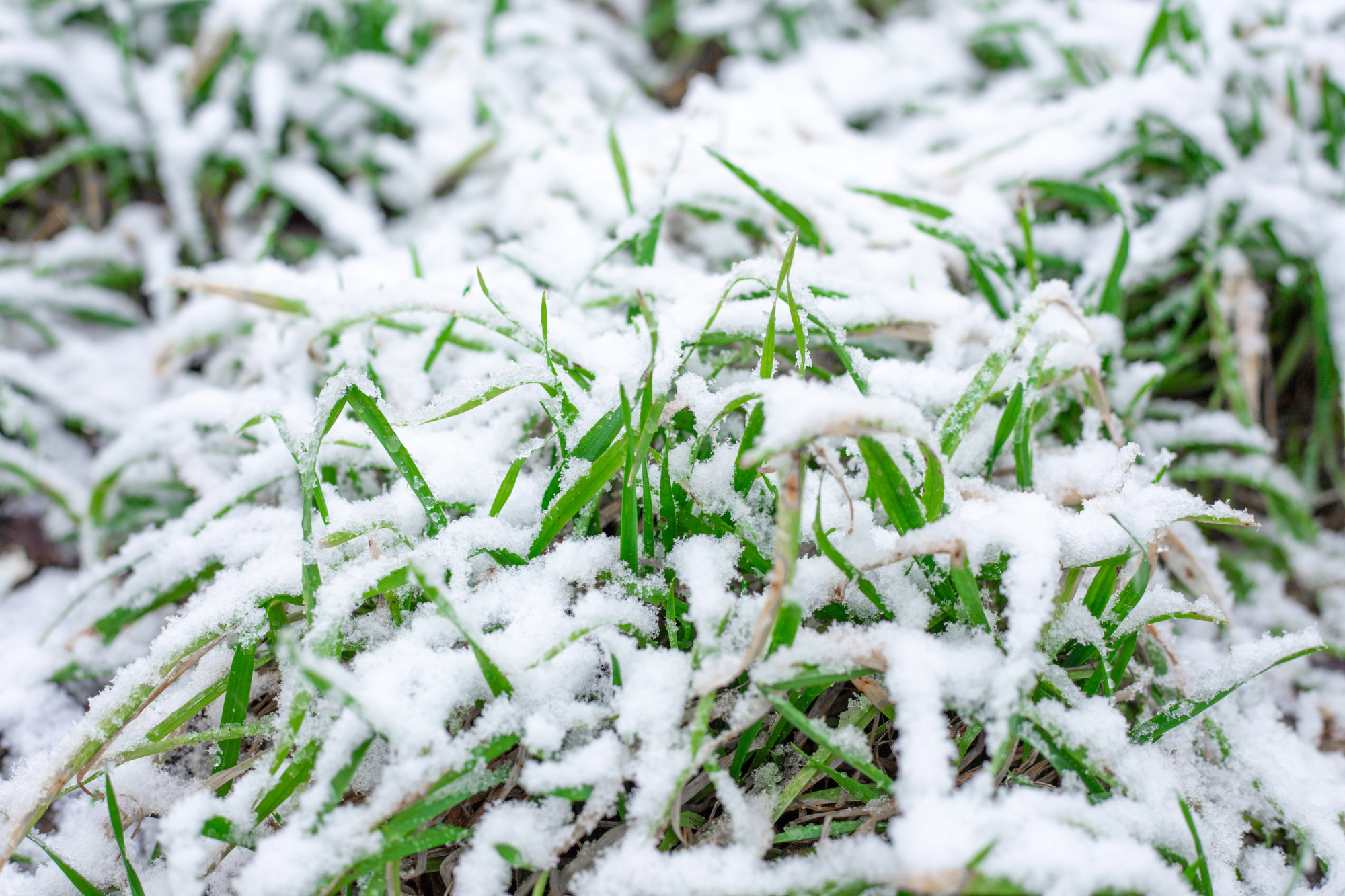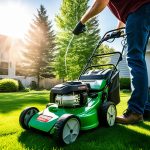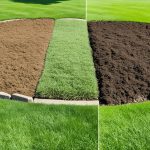As winter’s chill fades, homeowners turn their attention to their lawns. Assessing winter damage is crucial for restoring a lush, green landscape. A thorough evaluation of your lawn after winter helps identify problem areas and guides effective recovery strategies.
Walking your lawn is the first step in assessing damage. Look for thinning areas, dead patches, and signs of fungal growth like snow mold. Check soil compaction by pressing a screwdriver into the ground. If it’s difficult to penetrate, your lawn may need aeration to improve soil health and grass growth.
After identifying issues, plan your lawn’s recovery. This may involve removing debris, addressing soil problems, and preparing for reseeding or overseeding. With proper care and attention, your lawn can bounce back from winter damage and thrive in the coming growing season.
Key Takeaways
- Assess winter lawn damage by inspecting for dead patches and fungal growth
- Plan recovery strategies based on identified issues like soil compaction
- Prepare for reseeding and soil improvement to restore lawn health
Evaluating Winter Lawn Damage
Winter can take a toll on lawns, causing various types of damage. Proper assessment is key to developing an effective recovery plan.
Identifying Common Types of Winter Damage
Snow mold appears as circular patches of matted grass, often gray or pink in color. It thrives in areas where snow has compacted the turf. Salt damage from de-icing products manifests as brown, dead grass along driveways and walkways. Crown hydration occurs when grass absorbs water during warm spells, then freezes and expands, rupturing plant cells.
Winter desiccation results in dry, brown grass due to lack of moisture. Vole damage appears as narrow trails of dead grass beneath the snow. Pest damage may show up as small holes or torn-up areas in the lawn.
Assessing the Severity of Damage
Examine your lawn closely to determine the extent of winter damage. Look for dead patches, brown grass, and matted areas. Check for signs of pest activity such as burrows or chewed grass blades. Test soil moisture levels by inserting a screwdriver into the ground – if it goes in easily, moisture is adequate.
Evaluate the percentage of affected lawn area. Minor damage (less than 25%) may recover with proper care. Moderate damage (25-50%) may require overseeding. Severe damage (over 50%) might need complete renovation. Consider soil compaction, which can worsen winter stress. Press a screwdriver into the soil – if it’s difficult, aeration may be necessary.
Planning for Lawn Recovery
Successful lawn recovery after winter requires a well-thought-out approach. Focusing on timing and setting achievable goals can help ensure your grass returns to its lush, green state.
Setting Realistic Goals for Recovery
Assess your lawn’s current condition to establish attainable recovery objectives. Identify areas that need the most attention, such as bare patches or thinning grass. Prioritize these zones for targeted care.
Create a list of specific goals, such as:
- Filling in bare spots
- Improving overall grass density
- Enhancing soil health
Set a timeline for each goal, considering your local climate and grass type. Be patient, as full recovery may take several weeks or even months.
Choosing the Right Time to Begin
Timing is critical for effective lawn recovery. Start your efforts when soil temperatures consistently reach 55°F (13°C). This typically occurs in early spring, but can vary by region.
Watch for these signs that indicate it’s time to begin:
- Grass showing new growth
- Soil no longer frozen or waterlogged
- Nighttime temperatures staying above freezing
Begin with gentle raking to remove dead grass and loosen the soil surface. This prepares the lawn for seeding and fertilization. Avoid heavy foot traffic during this period to prevent further damage to fragile new growth.
Preparing for Reseeding and Overseeding
Proper preparation is key for successful lawn reseeding and overseeding. This process involves clearing the area of debris and dead grass, as well as choosing the right grass seed for your climate and lawn conditions.
Raking and Removing Thatch
Start by thoroughly raking the lawn to remove dead grass, leaves, and other debris. This step is crucial for exposing the soil surface and creating a good environment for new seed growth. Pay special attention to areas with thatch buildup, which can prevent seeds from reaching the soil.
Use a dethatching rake or power dethatcher for larger areas or heavy thatch. Remove all loose material after dethatching. This process improves seed-to-soil contact, essential for germination. It also helps identify bare patches or areas damaged by fungal diseases that may need extra attention during reseeding.
Selecting Quality Grass Seed
Choose grass seed that matches your existing lawn and thrives in your climate. Consider factors like sun exposure, soil type, and local weather patterns. Look for high-quality seed with a high germination rate and low weed seed content.
For overseeding, select a seed mix compatible with your existing grass type. In bare patches, you may opt for a different variety better suited to those specific areas. Read seed labels carefully to ensure you’re getting the right mix for your needs.
Consider buying a seed spreader for even distribution. This tool helps achieve consistent coverage, especially in larger lawns. Store unused seed in a cool, dry place to maintain its viability for future use.
Improving Soil and Lawn Health
Enhancing soil quality and promoting lawn health are essential steps for recovery after winter damage. Proper aeration and nutrient management can revitalize grass and create optimal growing conditions.
Aerating Compacted Soil
Aerating helps alleviate soil compaction, allowing air, water, and nutrients to reach grass roots more easily. Use a core aerator to remove small plugs of soil from the lawn, creating channels for better air circulation and root growth. This process is especially beneficial for areas with heavy foot traffic or clay soils.
Aerate when the soil is moist but not waterlogged, typically in early spring or fall. Make multiple passes over the lawn in different directions for thorough coverage. Leave the soil cores on the surface to break down naturally, as they contain valuable microorganisms and organic matter.
Balancing Soil pH and Nutrients
Conduct a soil test to determine pH levels and nutrient deficiencies. Most grasses prefer slightly acidic soil with a pH between 6.0 and 7.0. If the soil is too acidic, apply lime to raise pH. For overly alkaline soil, add sulfur to lower pH.
Based on test results, apply a balanced fertilizer to address specific nutrient needs. Nitrogen promotes leaf growth, while phosphorus and potassium support root development and overall plant health. Use slow-release fertilizers to provide steady nutrition and reduce the risk of nutrient runoff.
Incorporate organic matter like compost to improve soil structure and nutrient retention. This also helps support beneficial soil microorganisms, enhancing long-term soil health and grass vigor.
Maintaining Your Lawn Post-Recovery
Proper maintenance is key to keeping your lawn healthy after winter recovery. Regular care and attention will help prevent future damage and promote lush grass growth.
Regular Mowing and Watering Techniques
Mow your lawn consistently, adjusting the mowing height based on grass type and season. For cool-season grasses, set the mower blade to 2.5-3 inches in spring and fall, and 3-4 inches in summer. Warm-season grasses thrive at 1-2 inches year-round.
Water deeply but infrequently to encourage deep root growth. Apply 1-1.5 inches of water per week, preferably in the early morning. Use a rain gauge or tuna can to measure water output.
Avoid over-watering, which can lead to shallow roots and fungal diseases. Check soil moisture by inserting a screwdriver into the ground – if it goes in easily, skip watering that day.
Implementing Effective Fertilization Schedules
Test your soil pH and nutrient levels annually to determine fertilizer needs. Most lawns benefit from 2-4 applications per year, timed with natural growth cycles.
For cool-season grasses, apply fertilizer in early spring, late spring, early fall, and late fall. Warm-season grasses need fertilizer in late spring, early summer, and late summer.
Use slow-release fertilizers to provide steady nutrition and reduce the risk of burning. Apply at a rate of 1 pound of nitrogen per 1,000 square feet per application.
Water the lawn thoroughly after fertilizing to help nutrients reach the root zone. Avoid fertilizing during drought conditions or when grass is dormant.





